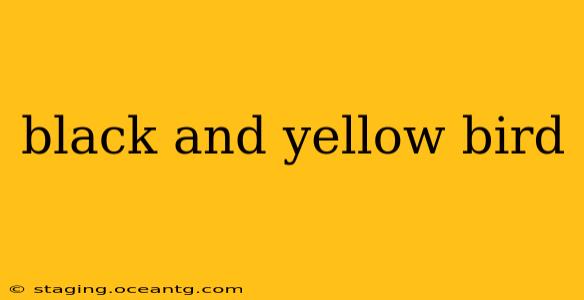Many birds sport striking black and yellow plumage, making identification a fun but sometimes challenging task. This guide will help you narrow down the possibilities, covering various species and their distinguishing features. Knowing the location where you spotted the bird is crucial for accurate identification, as different regions host different avian species.
What kind of black and yellow bird is this?
This is the most common question when encountering a black and yellow bird. The answer, however, requires more information. Consider these factors:
- Location: Are you in North America, Europe, Asia, Africa, or Australia? Even a specific state or province can significantly narrow the possibilities.
- Size: Is the bird small (like a finch), medium (like a robin), or large (like a hawk)?
- Habitat: Was the bird in a forest, field, backyard, wetland, or urban area?
- Behavior: Was the bird foraging on the ground, perched on a branch, or in flight? What was it eating?
- Song or calls: Did the bird make any distinctive sounds?
What are some common black and yellow birds?
Several bird species exhibit black and yellow markings. Let's explore a few prominent examples:
North American Species
- Yellow-rumped Warbler (Myrtle Warbler): A common warbler with a bright yellow rump and flanks, olive-green back, and black streaks on its breast. They are often seen in urban and suburban areas.
- Baltimore Oriole: A striking bird with a black back, head, and wings, contrasted by bright orange-yellow underparts. They are known for their distinctive nests hanging from branches.
- Black-and-gold Oriole: Similar to the Baltimore Oriole but with a more intense black and golden yellow color. Its range is more southwestern.
- Black-throated Oriole: This striking oriole boasts a glossy black head and back, with bright yellow underparts and a bright, bold yellow wing patch.
European Species
- European Goldfinch: This small, active finch features a bright red face, yellow wing patches, and black wings. They are often found in gardens and parks.
- Northern Flicker (European subspecies): While the North American Flicker has a more varied coloration, the European subspecies displays patches of black and yellow feathers.
Other Regions
Many other species worldwide boast similar black and yellow markings, requiring specific regional field guides for accurate identification.
What are some less common black and yellow birds?
Beyond the common species, numerous less frequently observed birds share similar color schemes. These often require a more in-depth examination of plumage details, size, and habitat. Consult a regional bird guide or ornithological resources for more specific information.
How can I identify a black and yellow bird?
The most effective way to identify a black and yellow bird is through a combination of observation and utilizing resources like:
- Field guides: These books provide detailed descriptions, illustrations, and range maps for various bird species.
- Online resources: Websites and apps like eBird, Merlin Bird ID, and Audubon offer helpful identification tools.
- Local birdwatching groups: Connecting with experienced bird watchers in your area can provide valuable insights and assistance.
Remember to note all the details mentioned earlier—location, size, habitat, behavior, and calls—to effectively narrow down the possibilities. A clear photograph can also be invaluable for identification.
What's the difference between a Baltimore Oriole and a Black-and-gold Oriole?
While both are stunning orioles with black and yellow plumage, subtle differences exist:
- Baltimore Oriole: More orange-yellow underparts.
- Black-and-gold Oriole: More intense golden-yellow underparts and a smaller overall size. The Black-and-gold Oriole also has a more limited range.
Careful observation of the shade of yellow is essential for differentiation.
This guide provides a starting point for identifying black and yellow birds. Remember that detailed observation and utilizing the resources mentioned above are crucial for accurate identification. Happy birding!
